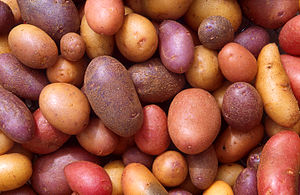In 2012, the contents of your children’s school lunch will be changing and it may no longer feature white potatoes in any form. The new School Lunch Rules that will be mandated in every public school beginning next year were recently unveiled by the USDA. In addition to many positive changes like mandating a maximum allowable calorie count per meal and the requirement that each meal include both fruit and vegetable offerings, there is a contentious recommendation to remove white potatoes almost entirely from the public school lunch program.
While everyone on both sides of the potato problem seems to agree on the importance of improving the quality of school lunches and ensuring the food offered supports a healthy diet, not everyone agrees that government mandates on which foods are acceptable and which foods are not is the right solution.
Julie Murphree of the Arizona Farm Bureau explained why many are against this part of the new rules in a recent interview with KTAR.
“One of the things they have to realize is….introduce more fruits and vegetables – don’t necessarily eliminate something that’s perceived to not have the nutrient value of the others. Potatoes are an important part of the mix.”
Murphree also explained that it is not the potatoes that are the problem; it is how they are prepared when served as part of a school lunch. Senator Susan Collins from Maine and the National Potato Council has also spoken out against the USDA recommendation. The Council’s CEO, John Keeling, told ABC News that forcing a limit on potatoes will increase cost, reduce the flexibility of the schools in running their lunch programs, and run the risk of decreasing the overall nutrition kids get from their lunch by taking away one of the most popular vegetables offered.
The bottom line argument from most opponents is that potatoes are more nutritious than many people think they are. Containing more potassium than a banana, as much protein as a half a glass of milk and 45% of the daily recommendation for vitamin C, an average size baked potato packs a powerful nutritional punch for only 110 calories and zero fat.
Those against the recommendation agree that potatoes, like all vegetables, have a place in a healthy diet. Rather than limiting the options available, opponents argue that providing a variety of vegetables, including potatoes, which are prepared with preservation of nutritional content in mind, is a better way to provide our children with the healthiest student lunch possible.
Potatoes are not the problem and banning them, along with their starchy cousins, corn and peas, is not the answer to the childhood obesity crisis. Limiting the ability of schools to offer the vegetables children like best won’t make them more likely to eat the other vegetables offered, it will just make them eat fewer vegetables. There is a place for vegetables of all shapes and sizes in a healthy diet and that variety should also be reflected on your child’s school lunch tray.
Related Posts:
- 5 reasons you should be happy supermarkets aren’t run like schools (fillyourplate.org)
- 7 little known facts about ice cream (fillyourplate.org)
- Some interesting facts about bacon (fillyourplate.org)




Pingback: 5 Ways to Make Healthier French Fries | Fill Your Plate Blog
Pingback: Focus on Agriculture: In Praise of All-American Food | Fill Your Plate Blog
Pingback: Marinades and Rubs for Your Beef Recipes: Tips to Better Seasoning | Fill Your Plate Blog
Pingback: How to Get Your Kids to Eat More Vegetables | Fill Your Plate Blog
Pingback: Potato Fight in the Cafeteria! | Julie's Fresh Air